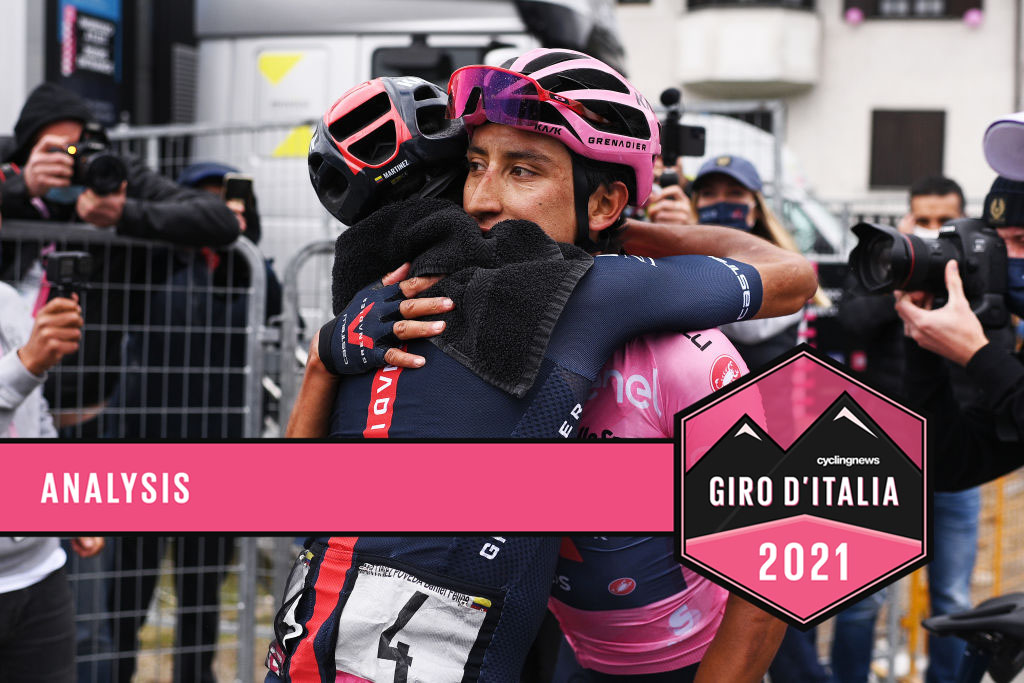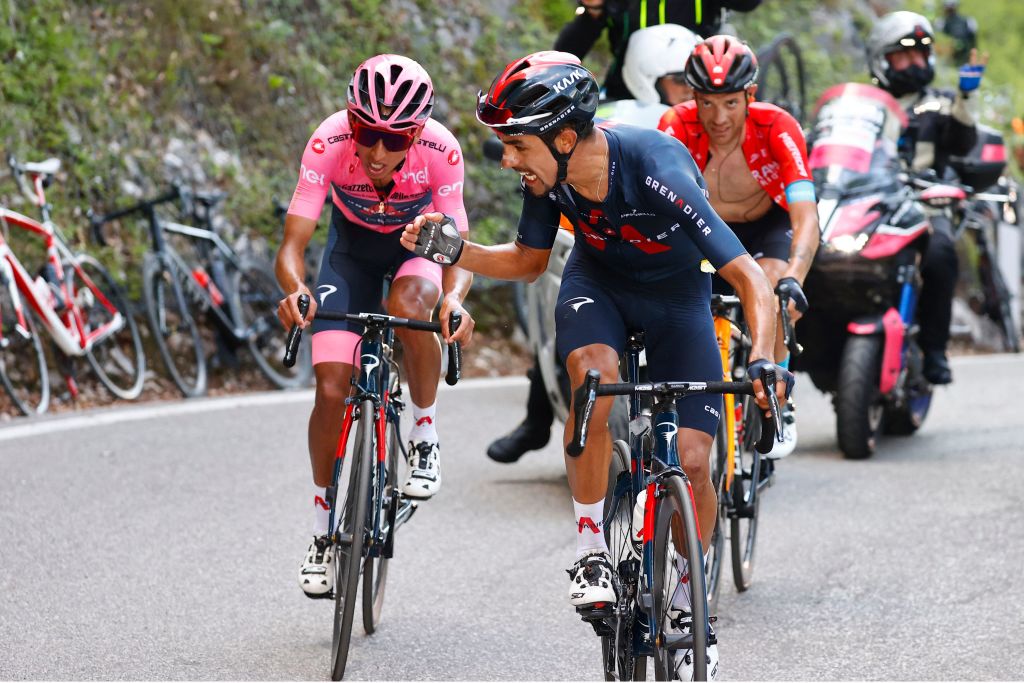Daniel Martínez steadies Egan Bernal’s course towards Giro d’Italia victory
Dauphiné winner and Castroviejo calm stormy waters on road to Alpe Motta

The Giro d’Italia set out from Turin with a myriad of possible scenarios but by the end of the opening week it already seemed clear that the most obvious one was likely to play out: Egan Bernal in pink and his Ineos Grenadiers team dictating terms to the rest of the peloton.
Simon Yates (Team BikeExchange), at Sega di Ala and Alpe di Mera, and Damiano Caruso (Bahrain Victorious), at Alpe Motta, brought some suspense into the final days of this Giro by unsettling Bernal and Ineos but their overall supremacy never truly seemed to be in doubt.
Every time a potential problem presented itself on this Giro, Ineos Grenadiers had the individual quality to solve it or the collective might to overwhelm it. Caruso’s foray off the front on the descent of the Passo San Bernardino on stage 20 was a case in point, given that it left Bernal more isolated than he might have expected on the final mountain stage of the race.
Forced to deplete the resources of other teammates during the lower stages of the penultimate climb to limit the gap, just Daniel Martínez and Jonathan Castroviejo were still by his side come the top of the Passo dello Spluga. Worse was to follow on the descent, where the pink jersey group briefly split and Bernal suddenly found himself with only Castroviejo for company. It was, by Bernal’s admission, “the most complicated moment” of his Giro.
Yet, as ever, the wrinkle was ironed out by the quality of his supporting cast.
Castroviejo, who had already controlled the situation on the climb of the Spluga, now had the presence of mind to stall the pink jersey group and wait for Martínez to rejoin. Martínez then had the raw climbing power to shepherd Bernal almost all the way up Alpe Motta.
Martínez’s relentless pace-making kept Caruso’s lead under control, while dissuading Yates from attacking. By the final two kilometres, his forcing was so irresistible that Yates was dropped altogether. The Giro was effectively over as a contest.
Get The Leadout Newsletter
The latest race content, interviews, features, reviews and expert buying guides, direct to your inbox!
All that remained was for Bernal to add the finishing touches, clipping away in the last 700 metres to take second on the stage. Martínez, his team duties complete, still summoned up the energy to beat Romain Bardet to third place. In the overall standings he is sixth overall and he might yet pip the Frenchman again by moving up to fifth in the final time trial in Milan on Sunday.
It wasn’t Martínez’s first such cameo on this Giro, where he has emerged as the most valuable of the cadre surrounding Bernal. At San Giacomo on stage 6 he beat a path for Bernal by attacking in the finale and he teed up his leader’s winning acceleration at Campo Felice three days later.
In the final week, his importance became ever more apparent. When Bernal surprisingly floundered at Sega di Ala, it was Martinez who hauled him ashore, both pacing and cajoling him towards the summit.

At Alpe di Mera on Friday, Martínez calmly pared back Yates’ lead to more manageable dimensions, before providing a supersonic encore at Alpe Motta.
“I’m a bit surprised by my level, I’ve always run out of gas in the last week,” Martínez told ESPN atop Alpe Motta. “I’m having my best form in a three-week race, which I hadn’t done before.”
Martínez’s best supporting actor role here is almost a reprise of Rohan Dennis’ remarkable performance in the final week of last year’s Giro, when his shows of force on the Stelvio and Sestriere ended Wilco Kelderman’s challenge and cleared Tao Geoghegan Hart’s path towards overall victory.
Dennis, like Martínez, is a rider who raced as a leader elsewhere before joining Ineos Grenadiers to ride predominantly in a supporting role. Just last August, Martinez won the Critérium du Dauphiné with EF Education First, but he has, at least for now, tempered his personal ambition in order to ride in his fellow countryman Bernal’s retinue.
Martínez wasn’t even the highest profile signing of Ineos’ transfer campaign last winter. Richie Porte, third at last year’s Tour de France, returned from Trek-Segafredo, also ostensibly to perform a supporting role, while Adam Yates was signed from Mitchelton-Scott.
Beyond Martínez and Castroviejo, Bernal’s supporting cast at this Giro included world time trial champion Filippo Ganna, Gianni Moscon and, prior to his early abandon, Pavel Sivakov. No other team in this race came close to matching that kind of depth.
Forget the so-called marginal gains, the most obvious advantage that Ineos hold over the rest of the peloton is not in the fine details but in the big picture.
Their most recently reported budget, for the 2019 season, was some €50.78 million, an increase of almost €8 million on the previous campaign and, by some distance, the biggest in cycling. The three wildcard squads on this Giro, by comparison, have budgets of under €4 million each. Same bike race, different planet.
If Bernal retains pink in Sunday’s final time trial, he will seal Ineos’ third Giro win in four years, each with a different rider. The squad has also landed seven of the last nine Tours, through four different riders. Leaders and personnel change, sponsors come and go, but the beat goes on.
After men like Froome, Porte, Poels and even Bernal himself, Martínez is the latest iteration of that recurring Sky/Ineos phenomenon: a domestique who was stronger than most of the other leaders in the race.
Having the best teammates doesn’t guarantee Grand Tour victory, of course, and Tadej Pogačar’s (UAE Team Emirates) triumph over Jumbo-Visma at last year’s Tour de France is proof of that. But it certainly makes life a lot more straightforward, as Bernal acknowledged after embracing Martínez past the finish line at Alpe Motta.
“Dani is a great rider,” Bernal said. “A lot of people knew that, but now he’s showing to the whole world.”

Barry Ryan was Head of Features at Cyclingnews. He has covered professional cycling since 2010, reporting from the Tour de France, Giro d’Italia and events from Argentina to Japan. His writing has appeared in The Independent, Procycling and Cycling Plus. He is the author of The Ascent: Sean Kelly, Stephen Roche and the Rise of Irish Cycling’s Golden Generation, published by Gill Books.